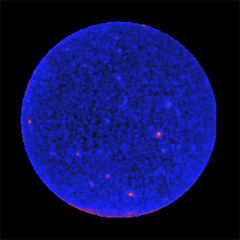This map of the northern galactic sky shows Large Area Telescope counts of gamma rays with energies greater than 300 million electron volts. (Image courtesy of NASA/DOE/LAT collaboration. Click on image to view a movie of this swath of sky between August 4 and October 30, 2008.)
The gamma-ray sky is intensely frenetic, twinkling with abandon. And now, thanks to a series of time-lapse movies released Friday by NASA, the US Department of Energy, and the Fermi Gamma-ray Space Telescope's Large Area Telescope collaboration, you too can enjoy the frenzy.
The movies, which were made public during a live webcast organized as part of the 100 Hours of Astronomy project, compress the space-based telescope's first 87 days of science data into as little as 29 seconds. On this time scale, the sky is awash in softly blinking gamma-ray sources, which are again and again overwhelmed by the bright firework-like flashes of bright blazars.
Some of the most violent energy sources in the universe, blazars are galaxies that emit jets of particles traveling near the speed of light. In a blazar, one of these jets is oriented directly toward Earth, creating a very strong signal in many wavelengths—including gamma rays.
In one of the just-released movies of the Northern Hemisphere (accessible by clicking on the image at right), a careful examination reveals the sun scooting across the sky on the lower right corner of the frame. Although the sun does not directly emit gamma rays, cosmic rays streaming through the universe continually strike the sun's gas and light, producing gamma rays. The sun's position with respect to the background stars on the sky changes by about 1 degree per day as the earth advances in its orbit, leading to the steady progression in this highly compressed movie.
"The moon is just as strong a gamma-ray source as the sun, but moves around the earth many times faster and so is smeared out to invisibility in these daily images," says Large Area Telescope deputy analysis coordinator Seth Digel, an experimental physicist at the Kavli Institute for Particle Astrophysics and Cosmology.
In the same movie, the faint but constant red speckles around the bottom and left edge of the frame correspond to the plane of the Milky Way galaxy, which is hot in gamma rays. And the two steady bright dots, one near the left edge and one just at the top, are pulsars in the Milky Way. The crushed cores left behind when massive stars explode, pulsars spin rapidly and sweep a lighthouse-like beam across the sky. When this beam is oriented so that it shines on Earth, we observe it to blink on and off as the star spins.
"It's funny, but we [the Large Area Telescope collaboration] consider pulsars steady sources," Digel says. "Unlike blazars, they don't change in brightness, they only pulse." Because the slowest gamma-ray pulsars flash a few times per second, their on-and-off nature isn't visible in the highly compressed time of the movie. But in the telescope's complete data, the flashes are quite clear; in fact, the Large Area Telescope was the first telescope to discern that one of these sources, LAT PSR J1836+5925 (the one on the left edge of the movie), is in fact a pulsar. Previously, it was known as a steady, unidentified gamma-ray object.
See what else you can discover in the Large Area Telescope time-lapse movies, which are all available on the NASA website.







